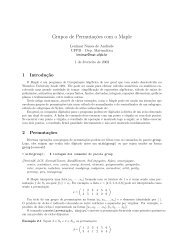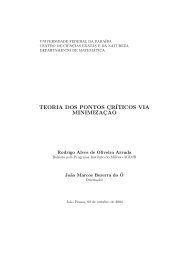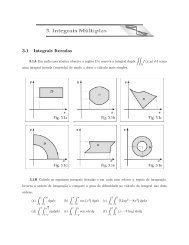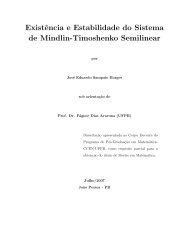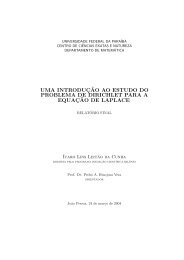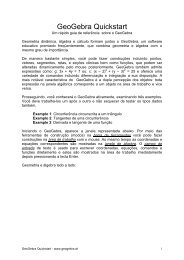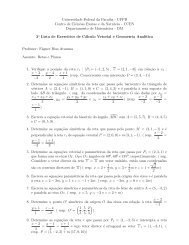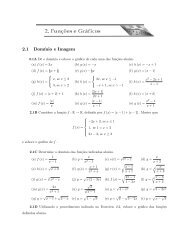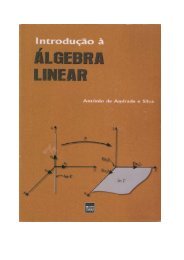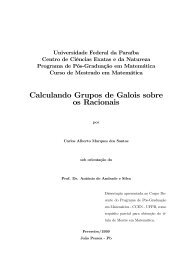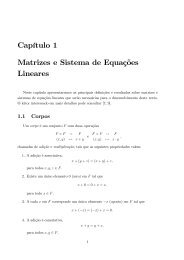Controlabilidade Exata e Aproximada da Equação da Onda Linear
Controlabilidade Exata e Aproximada da Equação da Onda Linear
Controlabilidade Exata e Aproximada da Equação da Onda Linear
Create successful ePaper yourself
Turn your PDF publications into a flip-book with our unique Google optimized e-Paper software.
Agora, considerando<br />
X(t) =<br />
⎡<br />
⎣ y(t)<br />
y ′ (t)<br />
segue de (A.4) que<br />
X ′ ⎡<br />
(t) = ⎣ y′ (t)<br />
y ′′ ⎤ ⎡<br />
y<br />
⎦ = ⎣<br />
(t)<br />
′ ⎤ ⎡ ⎤ ⎡<br />
(t)<br />
−λy + M<br />
0<br />
⎦ = ⎣<br />
−λ<br />
I<br />
⎦ ⎣<br />
0<br />
y(t)<br />
y ′ ⎤ ⎡<br />
⎦ + ⎣<br />
(t)<br />
0<br />
⎤<br />
M<br />
⎦ ,<br />
onde I é a matriz identi<strong>da</strong>de m × m, 0 é a matriz nula m × m e 0 é a matriz nula m × 1.<br />
Seja<br />
⎡ ⎤<br />
⎡<br />
0<br />
F1 (X, t) = ⎣<br />
−λ<br />
I<br />
⎦ X<br />
0<br />
e F2 (X, t) = ⎣ 0<br />
⎤<br />
M<br />
⎦ .<br />
Então encontrar solução para o sistema (A.4) é equivalente a resolver o seguinte sistema:<br />
⎧<br />
⎪⎨<br />
X<br />
⎪⎩<br />
′ = F1 (X, t) + F2 (X, t) ,<br />
⎡<br />
X (0) = ⎣ y0<br />
⎤<br />
(A.5)<br />
⎦ = X0.<br />
y1<br />
Mostremos que o sistema (A.5) está nas condições de Carathéodory. De fato, seja<br />
G = U × [0, T ], onde U = {x ∈ R 2m ; x ≤ b} , b > 0. Então<br />
• Fixando X, temos que F1 (X, t) não depende de t e F2 (X, t) é mensuravél, pois<br />
f ∈ L 1 (0, T ; H 1 0 (Ω)) . Logo F1 (X, t) + F2 (X, t) é mensuravél em t para X fixo.<br />
• Fixando t, F2 (X, t) não depende de X, então é constante e, portanto, contínua e<br />
F1 (X, t) é linear. Então F1 (X, t) + F2 (X, t) é contínua.<br />
• Como X varia em U, então to<strong>da</strong>s as entra<strong>da</strong>s de F1 (X, t) são limita<strong>da</strong>s por uma<br />
mesma constante. As entra<strong>da</strong>s de F2 (X, t) são funções integráveis em [0, T ] , pois as<br />
m primeras entra<strong>da</strong>s são nulas e as m últimas entra<strong>da</strong>s são, em valor absoluto, iguais<br />
a |(f(t), wj)| . Além disso,<br />
<br />
<br />
<br />
|(f(t), wj)| = f(s)wj <br />
ds ≤ |f(s), wj| ds<br />
Ω<br />
Ω<br />
<br />
≤ |f(s)| |wj| ds ≤ 1<br />
<br />
|f(s)|<br />
2<br />
2 ds + 1<br />
<br />
|wj|<br />
2<br />
2 ds < ∞.<br />
Ω<br />
Ω<br />
92<br />
⎤<br />
⎦ ,<br />
Ω



